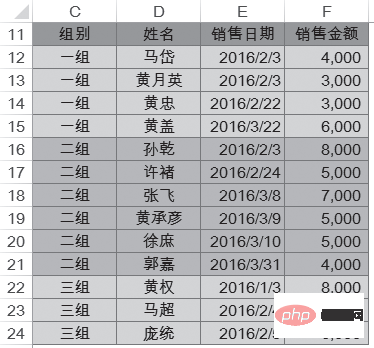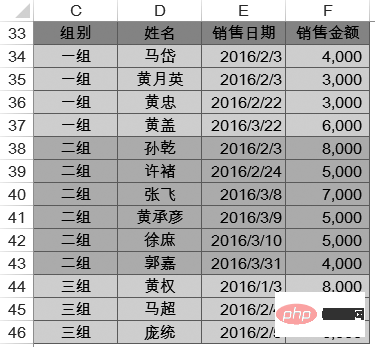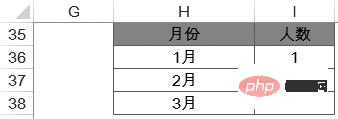Detailed explanation of Excel function COUNTIFS
This article brings you relevant knowledge about excel, which mainly introduces the basic syntax related knowledge of the COUNTIFS function. The syntax of this function is "COUNTIFS(criteria_range1,criteria1,[criteria_range2, criteria2]…)”, let’s take a look at it, I hope it will be helpful to everyone.

Related learning recommendations: excel tutorial
Basic syntax
The basic syntax of the COUNTIFS function is:
COUNTIFS(criteria_range1,criteria1,[criteria_range2,criteria2]...)
Among them, criteria_range represents the condition area to be counted, criteria represents the parameters to be counted, and is used to define the Which cells are counted.
The range of each criteria_range parameter must have the same number of rows and columns. Note here that its parameters appear "in pairs". In addition, COUNTIFS supports 127 pairs of conditional statistics. You only need to understand this knowledge point. Such complex conditions will not be used in daily work.
Perform statistics on strings, numbers, and dates respectively
As shown in Figure 19-1, the C11:F24 cell area is the basic data source, with C as the group and D as the Name, E is listed as sales date, F is listed as sales amount, and then corresponding statistics are made on this part of the data.

1. Case: Counting Chinese characters
First, let’s count the number of people in a group. Changing to the language of Excel, it can be translated into how many cells in column C are a "group". As shown in Figure 19-2, enter the formula in cell I12: =COUNTIFS(C12:C24,”A group”)

=COUNTIFS($C$12:$C$24,H14)

=COUNTIFS($F$12:$F$24,5000)

When doing numerical statistics, you can not only directly enter the conditions in the formula, but also place the conditions in the cells and then quote them directly. As shown in Figure 19-5, the cell areas H23:H25 are "> 5000""5000""

You can see that the statistical results are completely consistent with the previous ones. This has an advantage. If you need to modify the statistics in the future, You can modify the conditions directly in the corresponding cells of H23:H25 without modifying the formula, which is intuitive and fast. In actual work, try to consider the problem comprehensively, so that the function formula is in place in one step. In the future, you only need to modify it in the corresponding parameter area of the table.
Continue to look at a statistical data method, as shown in Figure 19-6. Enter the statistical separation point in cell H27, the number 5000, and then count "greater than", "equal to" and "less than or equal to" respectively. "Three sets of numbers. Enter the formula in cell I27:
=COUNTIFS($F$12:$F$24,”>”&H27)

Pay attention to this. Regarding the foreshadowing laid before, why are you required to write comparison operators and parameters separately? Many people will write the formula as “=COUNTIFS($F$12:$F$24,”>H27″)”. At first glance, the formula seems okay, but the result returned by this formula is 0. why? This is about talking about the issue of "activity".
H27 is not in double quotes, it maintains its "activity", which means it refers to the corresponding cell, but once it is placed in double quotes, it becomes a "mummy" , is no longer "active". ">H27" counts not the number 5000 that is greater than the number in cell H27, but the data that is greater than the three characters of "H27". In the statistics of COUNTIFS, it first determines the data type of the condition and finds that the data type is text, and the F12:F24 cell range is all numbers and no text, so the result is 0.
We use functions to reduce errors, so when you are not familiar with the function, write the comparison operator and parameters separately, and use "glue" (&) in the middle to stick them together. This can reduce 70 %mistake.
Continue to complete the other two statistics and enter the formulas in cells I28 and I29 respectively: =COUNTIFS($F$12:$F$24,”=”&H27)
=COUNTIFS( $F$12:$F$24,”
When the statistics are modified to use 3000 as the separation point, you only need to modify cell H27 to 3000, and other formulas do not need to be modified at all. can complete the work, as shown in Figure 19-7.

3. Case: Statistics Date
Let’s continue to look at the method of counting dates. In order to facilitate viewing the page, we establish the same data source in the C33:F46 cell area, as shown in Figure 19-8.

Count the number of people with a sales date in February 2016. Write down the formula first, and then analyze it slowly. As shown in Figure 19-9, enter the formula in cell I33: =COUNTIFS($E$34:$E$46,”>=”&”2016-2-1 ″,$E$34:$E$46,”

This function needs to pay attention to the following aspects.
(1) Review the date function discussed in Chapter 10. The essence of date and time is numbers. Counting dates in a certain interval is equivalent to counting the number between two numbers, so the method of "pinch off the beginning and remove the tail" is used.
(2) This method of quickly inputting dates must be enclosed in double quotes in English, otherwise it does not represent the date, but is just an ordinary number subtraction. If you don't master this method well, then use the DATE function in a disciplined manner, such as DATE(2016,2,1), to reduce errors.
(3) The data in this data source are all dates and do not include the time part, so use “”>”&”2016-1-31″””=1st of this month (4) COUNTIFS can reference the same area multiple times. Someone asked: "The statistical formula is too long. Can you use the MONTH function to extract the month of the date, and then use the COUNTIFS function to count how many months are equal to 2?" We will know the answer after we try it. Write the formula "=COUNTIFS(MONTH(E34:E46),2)" according to this method, and then press the [Enter] key. An error message appears in the system, as shown in Figure 19-10. Figure 19-10 Formula error message There is no problem with the logic of the formula, so what exactly is the error? The result of MONTH(E34:E46) is {2;2;2;3;2;2;2;3;3;3;3;1;2;2}, which is an array, and the first parameter in COUNTIFS is criteria_range. Note that "range" means a range, so the 1st, 3rd, 5th, 7th, ... parameters of COUNTIFS do not support arrays and must be a range, that is, a range of cells must be drawn in the Excel table. Parameters that have the same requirements as it include ref and reference. With the basis of the first statistical date, we continue. When making statistics, it is impossible to manually enter every month. In most cases, January, February, March, etc. are entered in the cells, and then the corresponding statistics are completed, as shown in Figure 19-11. Enter the following formula in cell I36 and copy it down to cell I38: =COUNTIFS($E$34:$E$46,”>=”&DATE(2016,LEFTB(H36,2),1),$E $34:$E$46,” The formula looks very long, let’s interpret it step by step . The formula LEFTB(H36,2), as mentioned in Section 7.5, extracts the left 2 bytes from the month, so only the number is extracted and "1" is obtained, and this space does not affect Calculation of DATE function. DATE(2016,"1",1) returns the result "42370", which is equivalent to the date 2016-1-1. Finally, use the COUNTIFS function to complete statistics for the corresponding month. Related learning recommendations: excel tutorial
The above is the detailed content of Detailed explanation of Excel function COUNTIFS. For more information, please follow other related articles on the PHP Chinese website!

Hot AI Tools

Undresser.AI Undress
AI-powered app for creating realistic nude photos

AI Clothes Remover
Online AI tool for removing clothes from photos.

Undress AI Tool
Undress images for free

Clothoff.io
AI clothes remover

AI Hentai Generator
Generate AI Hentai for free.

Hot Article

Hot Tools

Notepad++7.3.1
Easy-to-use and free code editor

SublimeText3 Chinese version
Chinese version, very easy to use

Zend Studio 13.0.1
Powerful PHP integrated development environment

Dreamweaver CS6
Visual web development tools

SublimeText3 Mac version
God-level code editing software (SublimeText3)

Hot Topics
 1359
1359
 52
52
 What should I do if the frame line disappears when printing in Excel?
Mar 21, 2024 am 09:50 AM
What should I do if the frame line disappears when printing in Excel?
Mar 21, 2024 am 09:50 AM
If when opening a file that needs to be printed, we will find that the table frame line has disappeared for some reason in the print preview. When encountering such a situation, we must deal with it in time. If this also appears in your print file If you have questions like this, then join the editor to learn the following course: What should I do if the frame line disappears when printing a table in Excel? 1. Open a file that needs to be printed, as shown in the figure below. 2. Select all required content areas, as shown in the figure below. 3. Right-click the mouse and select the "Format Cells" option, as shown in the figure below. 4. Click the “Border” option at the top of the window, as shown in the figure below. 5. Select the thin solid line pattern in the line style on the left, as shown in the figure below. 6. Select "Outer Border"
 How to filter more than 3 keywords at the same time in excel
Mar 21, 2024 pm 03:16 PM
How to filter more than 3 keywords at the same time in excel
Mar 21, 2024 pm 03:16 PM
Excel is often used to process data in daily office work, and it is often necessary to use the "filter" function. When we choose to perform "filtering" in Excel, we can only filter up to two conditions for the same column. So, do you know how to filter more than 3 keywords at the same time in Excel? Next, let me demonstrate it to you. The first method is to gradually add the conditions to the filter. If you want to filter out three qualifying details at the same time, you first need to filter out one of them step by step. At the beginning, you can first filter out employees with the surname "Wang" based on the conditions. Then click [OK], and then check [Add current selection to filter] in the filter results. The steps are as follows. Similarly, perform filtering separately again
 How to change excel table compatibility mode to normal mode
Mar 20, 2024 pm 08:01 PM
How to change excel table compatibility mode to normal mode
Mar 20, 2024 pm 08:01 PM
In our daily work and study, we copy Excel files from others, open them to add content or re-edit them, and then save them. Sometimes a compatibility check dialog box will appear, which is very troublesome. I don’t know Excel software. , can it be changed to normal mode? So below, the editor will bring you detailed steps to solve this problem, let us learn together. Finally, be sure to remember to save it. 1. Open a worksheet and display an additional compatibility mode in the name of the worksheet, as shown in the figure. 2. In this worksheet, after modifying the content and saving it, the dialog box of the compatibility checker always pops up. It is very troublesome to see this page, as shown in the figure. 3. Click the Office button, click Save As, and then
 How to type subscript in excel
Mar 20, 2024 am 11:31 AM
How to type subscript in excel
Mar 20, 2024 am 11:31 AM
eWe often use Excel to make some data tables and the like. Sometimes when entering parameter values, we need to superscript or subscript a certain number. For example, mathematical formulas are often used. So how do you type the subscript in Excel? ?Let’s take a look at the detailed steps: 1. Superscript method: 1. First, enter a3 (3 is superscript) in Excel. 2. Select the number "3", right-click and select "Format Cells". 3. Click "Superscript" and then "OK". 4. Look, the effect is like this. 2. Subscript method: 1. Similar to the superscript setting method, enter "ln310" (3 is the subscript) in the cell, select the number "3", right-click and select "Format Cells". 2. Check "Subscript" and click "OK"
 How to set superscript in excel
Mar 20, 2024 pm 04:30 PM
How to set superscript in excel
Mar 20, 2024 pm 04:30 PM
When processing data, sometimes we encounter data that contains various symbols such as multiples, temperatures, etc. Do you know how to set superscripts in Excel? When we use Excel to process data, if we do not set superscripts, it will make it more troublesome to enter a lot of our data. Today, the editor will bring you the specific setting method of excel superscript. 1. First, let us open the Microsoft Office Excel document on the desktop and select the text that needs to be modified into superscript, as shown in the figure. 2. Then, right-click and select the "Format Cells" option in the menu that appears after clicking, as shown in the figure. 3. Next, in the “Format Cells” dialog box that pops up automatically
 How to use the iif function in excel
Mar 20, 2024 pm 06:10 PM
How to use the iif function in excel
Mar 20, 2024 pm 06:10 PM
Most users use Excel to process table data. In fact, Excel also has a VBA program. Apart from experts, not many users have used this function. The iif function is often used when writing in VBA. It is actually the same as if The functions of the functions are similar. Let me introduce to you the usage of the iif function. There are iif functions in SQL statements and VBA code in Excel. The iif function is similar to the IF function in the excel worksheet. It performs true and false value judgment and returns different results based on the logically calculated true and false values. IF function usage is (condition, yes, no). IF statement and IIF function in VBA. The former IF statement is a control statement that can execute different statements according to conditions. The latter
 Where to set excel reading mode
Mar 21, 2024 am 08:40 AM
Where to set excel reading mode
Mar 21, 2024 am 08:40 AM
In the study of software, we are accustomed to using excel, not only because it is convenient, but also because it can meet a variety of formats needed in actual work, and excel is very flexible to use, and there is a mode that is convenient for reading. Today I brought For everyone: where to set the excel reading mode. 1. Turn on the computer, then open the Excel application and find the target data. 2. There are two ways to set the reading mode in Excel. The first one: In Excel, there are a large number of convenient processing methods distributed in the Excel layout. In the lower right corner of Excel, there is a shortcut to set the reading mode. Find the pattern of the cross mark and click it to enter the reading mode. There is a small three-dimensional mark on the right side of the cross mark.
 How to insert excel icons into PPT slides
Mar 26, 2024 pm 05:40 PM
How to insert excel icons into PPT slides
Mar 26, 2024 pm 05:40 PM
1. Open the PPT and turn the page to the page where you need to insert the excel icon. Click the Insert tab. 2. Click [Object]. 3. The following dialog box will pop up. 4. Click [Create from file] and click [Browse]. 5. Select the excel table to be inserted. 6. Click OK and the following page will pop up. 7. Check [Show as icon]. 8. Click OK.




